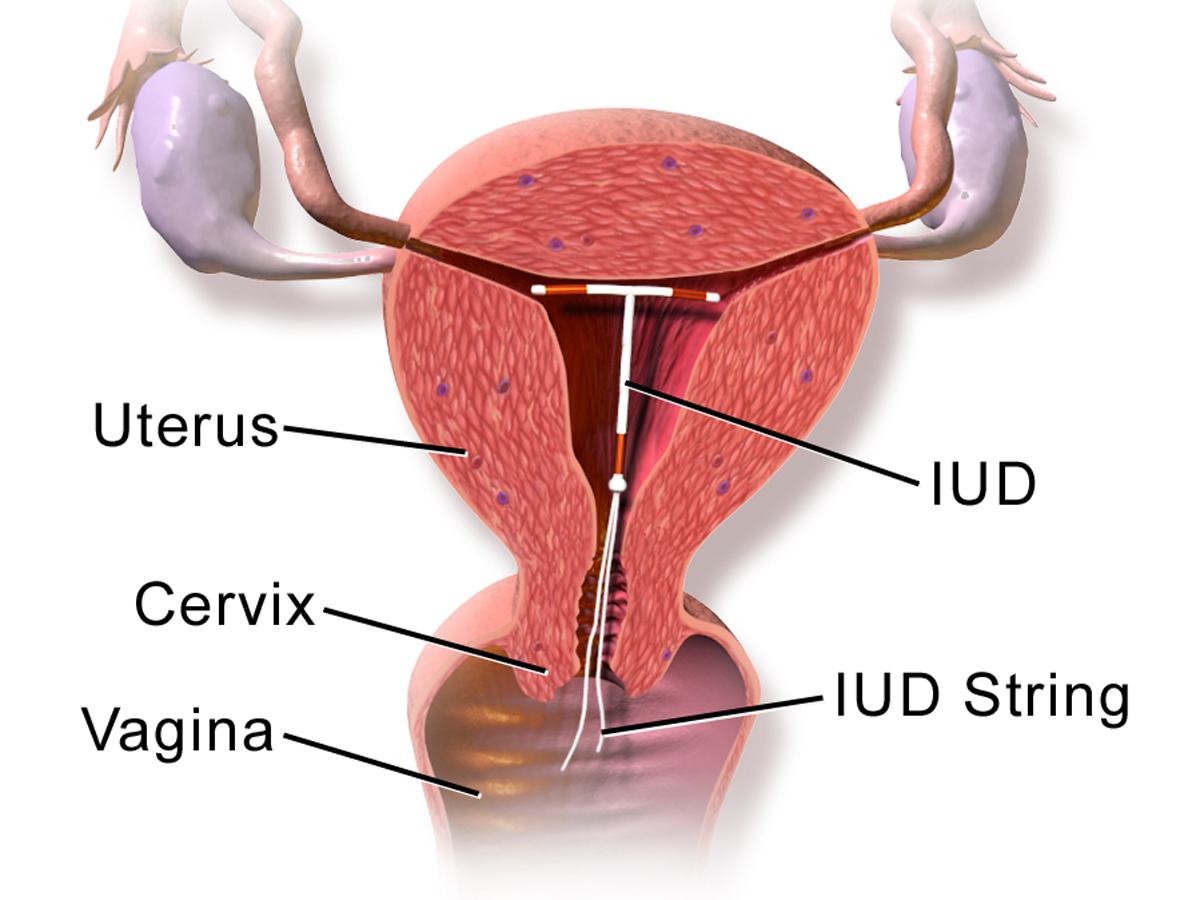My IUD And Me: Coils And Contraception Services In Bristol
Laura charts the trials, tribulations and jubilations of getting an IUD fitted, and why you should consider one.
So, there comes a time when you just want a long-term method of contraception.
So, there comes a time when you just want a long-term method of contraception. For me the natural choice seemed an IUD, a copper coil to be precise. It may not be as well-known or as popular as other methods, such as the pill, but at over 99% effective it’s as good if not better – plus there’s no need to remember to take a tablet every day.
If you’re not so keen on the idea of hormonal birth control, a copper coil is about the only thing left to prevent a pregnancy, with the exception of condoms (prone to breaking and at the mercy of human error/desire) and straight up abstinence. Personally, the thought of hormonal methods such as the pill or the implant didn’t appeal. Don’t get me wrong, it’s not because I’m some kind of modern medicine-fearing cave dweller. It’s just the idea of using synthetic hormones to trick my body kind of creeps me out. An implant that fools your body into thinking it’s already pregnant for three years? Euggh, no thanks. So I did some investigating, and hey presto. The copper coil sounded viable.
So the first thing I did was pay a visit to my GP. She talked through all the options, including what was involved with having an IUD fitted (more on that later), how long it would last, and what to expect once it was ‘in there’.
An implant that fools your body into thinking it’s already pregnant for three years?
In order to have an IUD fitted, she explained, the doctor or nurse has to be sure that there’s no possibility of the early stages of a pregnancy. So I was given the option of abstaining from sex for four weeks, or going on the pill temporarily. As I saw my GP at the end of November and she couldn’t fit the coil until January, I opted for taking the pill temporarily. While I wasn’t keen on the idea it seemed the simpler option. Plus, being on the pill means that you may have the coil fitted at any time, whereas with abstinence you must have the coil fitted within seven days of your last period.
So, January rolled around and I nervously attended the fitting appointment. The GP and the nurse made small talk about Christmas while I lay there, legs spread-eagled with a sheet of clinical paper to protect my modesty. I won’t lie, it wasn’t the most comfortable of experiences, on many levels. If you’ve ever had an examination ‘down there’ you’ll know that having your vagina held open with an instrument, while someone shines a light up there and pokes around isn’t exactly a day at the beach.
I can’t say it was painful, but the feeling of someone inserting a contraption six inches into your torso, to dilate your cervix, is bizarre to say the least. It felt so odd that I was super tense and the doctor couldn’t make any headway with opening my stubborn cervix whatsoever, exclaiming that I had ‘wonderful pelvic tone’. Well, thank god. In the end, the mission had to be aborted and I felt pretty dejected.
After talking through all avenues, I opted to be referred to the Bristol Sexual Health Services, where a specially trained Doctor would be able to administer a ‘cervical block’. This is basically an injection in the cervix that numbs the area, allowing for a more comfortable insertion process.
…me and my cervix turn up at the clinic for round two.
So a couple of months later me and my cervix turn up at the clinic for round two. The Bristol Sexual Health Clinic isn’t exactly the most appealing of buildings – located in central Bristol it looks a bit worn, as though it could do with a fresh lick of paint. Trying hard to set aside feelings of growing trepidation, I go in and find, to my relief, that the inside isn’t nearly as bad. It definitely has a very ‘clinical’ feel, the lino, stark corridors and hushed atmosphere don’t exactly create a feeling of warm welcome. Sitting there awaiting my turn, studying the posters warning against gonorrhoea and HIV makes me feel cold, sweaty and a bit lightheaded. I try to breathe deeply and sip water to take my mind off the posters that would make a vestal virgin feel paranoid.
Finally it’s my turn. The Doctor is warm and friendly and puts me at ease straight away. Before anything she goes through a list of questions – everything from family health history to ‘when was the last time you had sex?’. She calmly explains what she’ll do: a quick internal examination to check the size/position of my uterus, insert the speculum, give me the cervical block, pop a clip in to hold the cervix open (yikes), measure my womb to figure out how far to insert the IUD, then finally, insert the IUD itself.
Once again I assume the position; legs held aloft by stirrups while I lay back. While it may not be the most flattering position ever, the beds at the clinic, with their ability to move up and down, stirrups to keep your legs out of the way and a reclining rather than a flat bed actually make things a lot easier. Compared to lying on a tiny little bed, in a cramped GP surgery this was the lap of luxury.
So in goes the speculum.
So in goes the speculum. So far so good. Next up, some anaesthetic gel and the cervical block. There’s three little scratches with the needle, apparently – after the first I don’t notice. I just feel a little pressure, as the first needle pushes into the spongy tissue; after that my cervix is blissfully unaware of anything unusual for the next few minutes. The doctor is very calm and she keeps me talking too, so there’s no chance to focus on what’s going on. In the end, the doctor pops in the Nova T380 (not as swanky as it sounds, I’m sure) a five-year model, that’s slightly smaller and more flexible, having tried the ten-year version which simply wasn’t going in.
In the end, the whole experience is quick and pain free, much to my relief. Hopping off the bed and getting dressed again I feel pretty impressed with myself, and wonder what I’d worried about.
There was a little blood after, but nothing a pad wouldn’t sort out. Leaving there with instructions for checking the coil is still in place by feeling for the strings (they feel a bit like fishing line, FYI), I skip out of there feeling pretty happy. About ten minutes later very, very intense cramps kick in that feel as though, well, they feel as though your reproductive organs have just been manually dilated and a foreign object shot in. The poor things, I can’t honestly say I blame them for protesting. Thankfully I didn’t feel faint, although apparently some women do. I’d taken ibuprofen about an hour before and went straight to bed. A hot water bottle helped too. And tea and a big bar of chocolate.
Cons
Being on the pill for four months was frustrating, especially as I had only intended to be on it for 6-7 weeks. However, it was a shame my first fitting didn’t work out and this wasn’t really anyone’s fault.
The fitting process is just that – a process. It can be quite intimidating, and I don’t really think anybody enjoys showing off the depths of their vagina. If you don’t like hospitals, embarrass easily or you’re really, really squeamish this may not be the one for you.
Pros
Yes, the fitting can be uncomfortable but the few minutes of discomfort mean you’ll have a birth control option that you can pretty much forget about for the next 5-10 years.
There’s no need to remember to take anything daily, plus you’ll be free of the pesky side effects of hormonal contraception: being very emotional, very argumentative, and being hungry All. The. Time. Unfortunately for my friends, family and boyfriend I was all of the above while on the pill.
If you’re sick or have diarrhoea your contraception won’t be affected, unlike with the pill. So if you’re prone to stomach upset, or are travelling and eat something a bit dodgy, this could be a good option.
Need to know
You’ll be offered an STI test at the time of insertion, which involves swirling a cotton bud around your vagina a few times and sending it off to the lab – the Doctor or nurse can do this for you. If you’ve had a test previously that’s come back clear, and you haven’t had any sexual contact with a new partner then you won’t need one again.
Talk to us about sexual health things. Let’s not have any taboos. It’s for our own protection (geddit? Geddit?) Facebook or Twitter
For more information on sexual health services in Bristol, check out 4yp
Here are other sexual health organisations in Bristol
For information on IUDs, as well as other types of contraception, visit the Family Planning Association website.

About Rife






